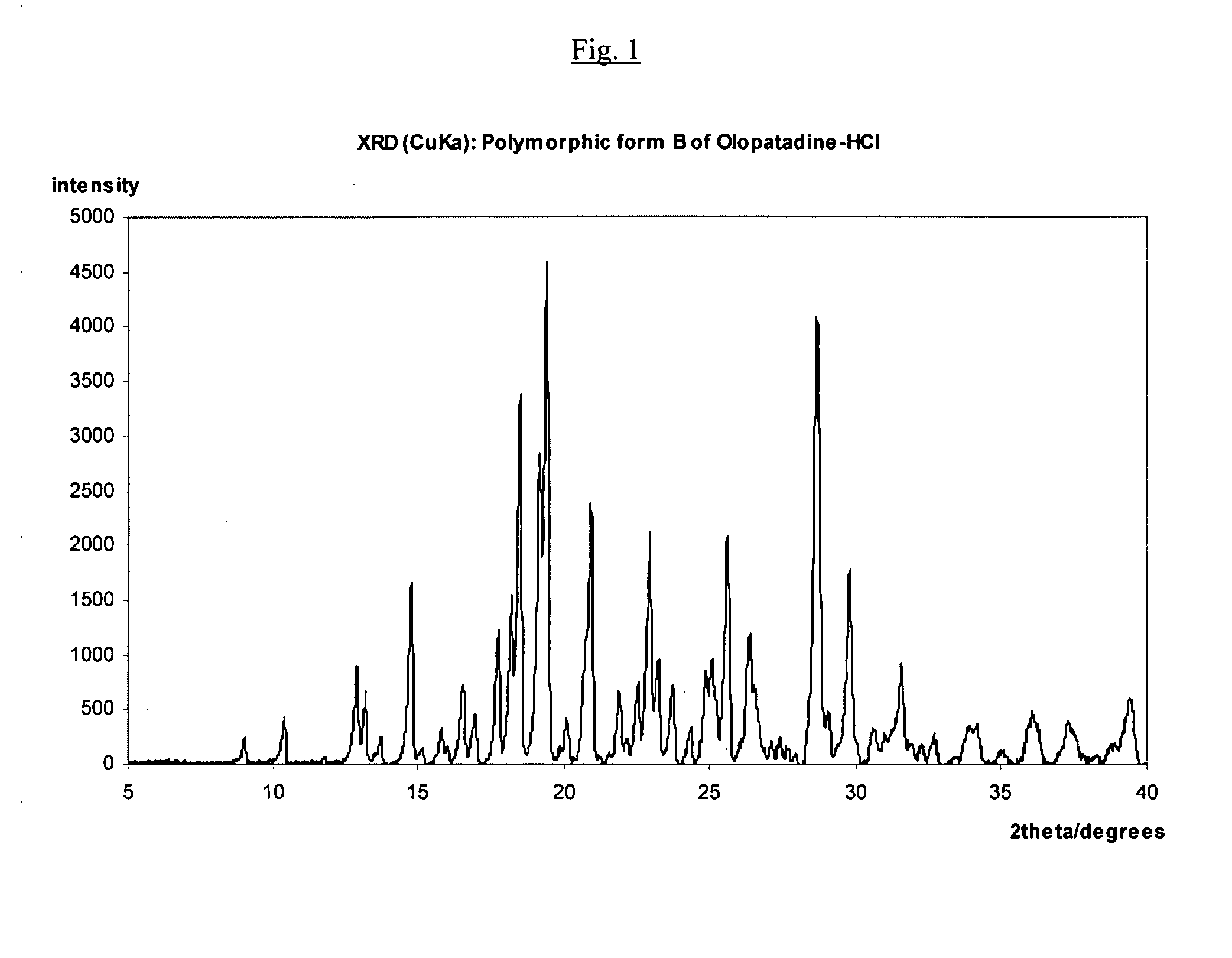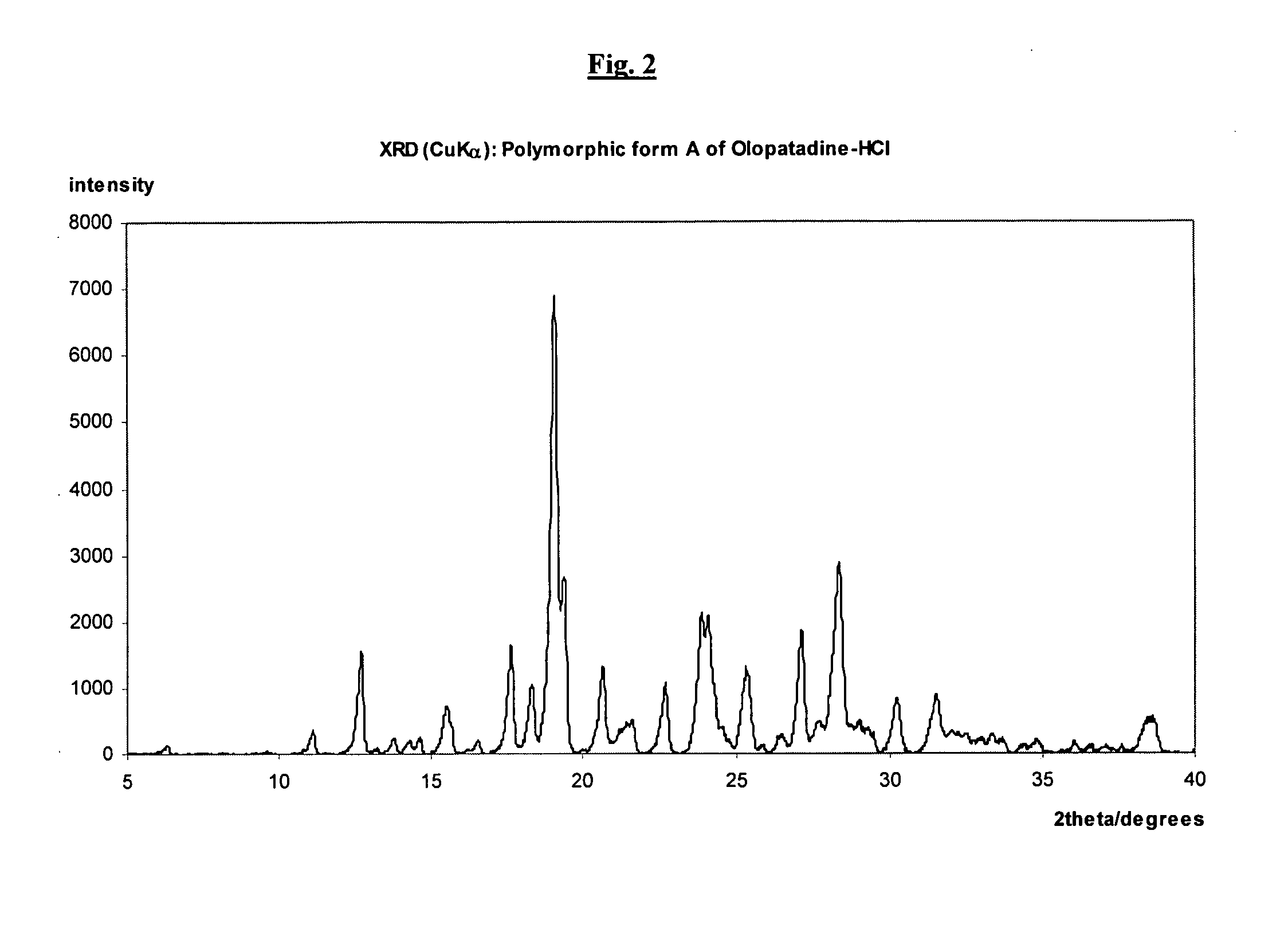Polymorphic forms of olopatadine hydrochloride and methods for producing olopatadine and salts thereof
a technology of olopatadine and hydrochloride, which is applied in the field of polymorphic forms of olopatadine hydrochloride, can solve the problems of reducing the synthesis efficiency of olopatadine, and reducing the synthesis efficiency of olopatadine. the effect of reducing the synthesis efficiency
- Summary
- Abstract
- Description
- Claims
- Application Information
AI Technical Summary
Problems solved by technology
Method used
Image
Examples
example 1
Synthesis of the Intermediate 4-(2-Carboxybenzyloxy)Phenylacetic Acid (Olo-IM1)
[0118] A solution of 4-hydroxyphenylacetic acid (90.0 g, 0.58 mol; assay >98%) and phthalide (85.07 g, 0.63 mol) in DMF (323 g) was heated to an internal temperature of 130° C. The pressure was reduced to 800 mbar and sodium methoxide (224.6 g, 1.25 mol, assay: 30% methanolic solution) was added slowly to the mixture maintaining the internal temperature above 100° C. During the addition methanol was distilled off, and after the addition the distillation was continued under normal pressure until the internal temperature increased to 130° C. again (260 g distillate). After stirring at this temperature for 6.5 h, phthalide (8.5 g, 0.06 mol) was added and the mixture was stirred overnight (16 h). Afterwards the mixture was cooled to 100° C. and hydrolyzed with water (1040 g). After cooling to <10° C., the pH of the mixture was adjusted to pH 1 with hydrochloric acid (163.5 g, 1.43 mol; assay: 32%). The produ...
example 2
Synthesis of the Intermediate 6,11-dihydro-11-oxo-dibenz[b,e]oxepin-2-acetic acid (Olo-IM2)
[0120] To a suspension of 4-(2-carboxybenzyloxy)phenylacetic acid (Olo-IM1) (300.09 g, 1.04 mol; assay: 99.0%) and trifluoromethane sulfonic acid (4.77 g, 0.03 mol; assay: 98.0%) in toluene (1122 g) was added slowly trifluoroacetic anhydride (255.18 g, 1.20 mol; assay: 99.0%) at 20-35° C. The brown solution was stirred after complete addition of trifluoroacetic anhydride for 1 hour at 20-25° C. and the mixture was then hydrolyzed with water (99.0 g). Afterwards, the mixture was distilled under normal pressure until the steam temperature was 105-110° C. (1191 g two-phase distillate). The residue was diluted with toluene (261 g) and the suspension was heated to reflux. The dark solution was then cooled to 75° C. and seeded with crystals of 6,11-dihydro-11-oxo-dibenz[b,e]oxepin-2-acetic acid (Olo-IM2). The suspension was stirred after cooling to 20-25° C. for additional 1-2 hours at this tempera...
example 3
Synthesis of the Intermediate 3-bromopropyltriphenylphosphonium bromide (Olo-IM3)
[0121] To a stirred solution of triphenylphosphine (511 g, 1.85 mol; assay: 95.0%) in toluene (800 g), 1,3-dibromopropane (371 g, 1.82 mol; assay: 99.0%) was added slowly within 1 hour at <5° C. After complete addition the solution was heated to reflux for 17 hours whereupon a suspension was obtained which was then cooled to room temperature. The product was filtered off at 20° C., washed with toluene (2×800 g) and dried under vacuum (21 h, 60° C.) to give 3-bromopropyltriphenylphosphonium bromide (Olo-IM3) as a white, crystalline solid (yield: 757 g, 1.63 mol, 89.6%).
PUM
 Login to View More
Login to View More Abstract
Description
Claims
Application Information
 Login to View More
Login to View More - R&D
- Intellectual Property
- Life Sciences
- Materials
- Tech Scout
- Unparalleled Data Quality
- Higher Quality Content
- 60% Fewer Hallucinations
Browse by: Latest US Patents, China's latest patents, Technical Efficacy Thesaurus, Application Domain, Technology Topic, Popular Technical Reports.
© 2025 PatSnap. All rights reserved.Legal|Privacy policy|Modern Slavery Act Transparency Statement|Sitemap|About US| Contact US: help@patsnap.com



